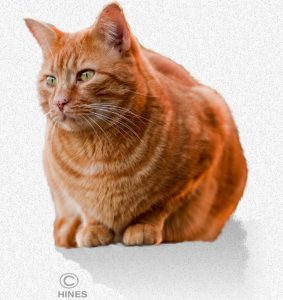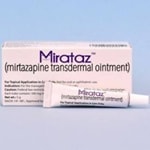Ron Hines DVM PhD
What Is Hepatic Lipidosis?
Hepatic lipidosis occurs when an abnormally high amount of fat (plasma lipids) accumulate in the cells of your cat’s liver. It occurs frequently in cats because as a species, they have a harder time than most animals in shifting gears to live off of their fat reserves when they do not or cannot eat. Dogs and humans are much better at that. When the fat in your cat’s liver builds up rather than being turned into usable energy, your cat’s liver looses its ability perform its vital functions. Hepatic lipidosis is the most common form of liver disease in pampered, middle-aged domestic cats. It occurs most commonly in overweight cats. The underlying causes include obesity, intestinal issues such as IBD , triad disease, pancreatitis, a stressful home environment, inter-cat aggression, diabetes, and underlying cancers such as lymphoma – anything that would make your cat less interested in eating. Hepatic lipidosis and it’s result, fatty liver disease, can be fatal if it is not corrected quickly by your veterinarian.
Some still explain hepatic lipidosis in cats as something that simple occurs when a house cat will not eat for any reason. But it is more complicated than that. The wild cats that gave rise to your domestic house cat and who still roam free in Europe and Asia loose almost a third of their body weight in the winter when prey is scarce. But they do not develop hepatic lipidosis. My thoughts are that their diet and the large amount of wandering exercise required to find their prey and survive protects them. I am also suspicious that the large amounts of carbohydrates added to commercial cat foods to increase company profits plays a part in this disease. The fact that all reports find hepatic lipidosis more common in cats in the UK, Canada and the USA than in the less developed world adds to my suspicions that diet and lifestyle play a major role in this disease.
How Long Might It Take For Hepatic Lipidosis to Develop?
Most cats begin to develop signs of hepatic lipidosis within 3-7 days after they have stop eating. However that time period is variable. Those cats eating substantially less than their normal amount of food but still eating a bit can take two weeks or so to finally develop the problem. The early signs are also easy to overlooked: decreased activity (lethargy), less interest in their surroundings, drooling (ptyalism), the beginnings of weight loss and gums that are paler than normal. But at that early stage of hepatic lipidosis, your cat’s blood bilirubin level is already rising as the cat’s liver struggles to process waste red blood cell hemoglobin. The cat’s blood ALT and ALP enzyme levels usually begin to rise as well. You might notice that your cat is disheveled (not grooming itself like it should). You might notice that its eyes have mater at their nose-side corners (medial canthus) due to dehydration or that its third eyelids are slightly over extended and visible.
What Is Going On In My Cat’s Body?
When your cat doesn’t eat, its fat stores begin to mobilize (lipolysis) and their components, free fatty acids and triglycerides, are liberated into its bloodstream to take the place of the calories the cat is no longer getting from food. Some of those fatty acids are absorbed by its liver. Much of the rest is used as fuel by the cat’s muscles. In a normal liver in other species, those fatty acids would be used to supply the large amounts of energy needed to perform the liver’s many vital functions. Those include processing absorbed nutrients, regulating blood sugar, eliminating toxic substances and manufacturing blood proteins. But in cats (particularly fat, inactive Garfield cats), this fatty acid mobilization to the liver to produce its needed energy fails. The fatty acids do get to the liver, but for reasons yet unknown they are not processed – they just accumulate. Insulin resistance may play a part in that. The fats accumulate in the cat’s liver cells (hepatocytes) in their “triplet” triglyceride fat form swelling the hepatocytes to a point where vital cell functions are blocked. Love is blind. Many cat owners are so attached to their cherished cats and take such pleasure in their company that they are not good at recognizing a potential health issue that is looming or won’t accept the notion that their cat is too chubby for its own good. ( read here & here) When I once attempted to diplomatically point out a weight issue in one of my cat-owning client’s cat, her response was “Yes, but he wears it well! “.
In Advanced Hepatic Lipidosis, What Other Signs Might I See?
Your cat will be much more obviously sick. If you look at the whites of its eyes (its sclera) they will usually have a slight to moderate yellowish tinge (jaundice). Your cat will be lethargic. It will not eat. It usually drinks much less than it should. It is quite likely that on occasion it will gag, vomit and drool. It may cease to defecate. If it does pass stools they may be dryer than normal due to dehydration and lowered intestinal motility. A few with underlying IBD , pancreatitis or partial intestinal obstructions might present with diarrhea. It is likely for its gums to be pale due to anemia. That anemia is due to the accumulation of toxic products in its blood stream that suppress red blood cell formation (aplastic anemia). At typical pose or stance is with its neck bent downward as in contemplation (ventroflexion).
What Tests Might My Veterinarian Run?
These cats need a blood chemistry panel and a white blood cell differential count. Your cats blood ALP level will most likely be quite high. That is because ALP enzyme leaks out of damaged liver cells. As I mentioned earlier, its blood bilirubin values will probably also be above normal – almost certainly if it is jaundiced. ALT liver enzyme levels are usually high as well; but GGT, another liver damage marker enzyme, levels are inconsistent (variable).
Your cat’s blood cholesterol level is likely to be high due to biliary stasis. Its blood ammonia level is likely to be high because the liver of cats with hepatic lipidosis looses much of its ability to convert ammonia into less-toxic urea. Blood ammonia levels are difficult to measure accurately and rarely included in standard blood analysis panel. They are generally reserved for the diagnosis of suspected hepatic encephalopathy.
As I mentioned, many of these cats (about a third) are anemic (the non-regenerative form) because toxic products normally eliminated by their liver begin to interfere with the ability of their bone marrow to produce replacement red blood cells. A few probably become anemic due to bleeding tendencies that develop as their liver looses their ability to produce prothrombin and other blood clotting factors.
There are many severe diseases that cause alterations in a cat’s blood electrolytes. Hepatic lipidosis is one of them. Those electrolyte changes when they occur are not diagnostic for hepatic lipidosis. But any major alterations in your cat’s blood electrolyte elements (ie sodium, potassium, calcium, magnesium , chloride, phosphate or carbonate) need to be corrected with intravenous fluids to help your cat recover.
An analysis of your cat’s urine might reveal that the ketone level is high. That often occurs in animals and people when they are forced to utilize stored fat for energy instead of utilizing the glucose that is normally stored as glycogen, in the liver. The nausea and weakness that accompanies ketoacidosis adds to your cat’s lack of interest in food.
Your veterinarian might elect to confirm his/her diagnosis of HL with an ultrasound-directed or fine needle liver biopsy/aspirate sent to a veterinary pathologist to rule out other forms of liver injury. That is particularly true if some of your cat’s examination results are not compatible with hepatic lipidosis or if it fails to respond to therapy. Your vet might also use the ultrasound examination of your cat’s liver to confirm that the entire organ is involved. In other liver diseases such as lymphoma tumors or abscesses, the pathology (damage) is patchy and limited to specific portions of your cat’s liver. In HL, the entire liver is involved.
Did HL Occur In My Cat Due To Some Underlying Health Issue?
I mentioned earlier that that is usually the case. Most veterinarians believe that there is always an underlying stressor(s) or disease process going on when HL occurs. One reason for that opinion is that it is very difficult for scientists to produce hepatic lipidosis in cats that don’t have underlying health issues or a serious obesity problem. Even cutting a healthy cat’s food intake by 25-45% did not produce HL in one study. (ask me for for Laflamme2005)
In a few very fortunate cats it was a change in its environment that your cat didn’t like. One that can be corrected. Perhaps a new cat added to the household. Perhaps a stay at a boarding cattery, pet “resort” or your Aunt Ida’s. Perhaps it was the new “All Vegan” diet that didn’t support its metabolism. (read here) Perhaps it was a bad reaction to a medication or some magic supplement that you read about online. (read here)
Hepatic lipidosis can also be the end result of chronic inflammatory problems affecting your cat’s digestive tract and/or the tract’s accessory organs, the pancreas, gall bladder, bile duct and liver. (read here) In older cats, the toxic byproducts of the common feline cancers must also be considered a possible cause. Viruses, such as the coronavirus of FIP can also underlie the condition. (ask me for Trotman2007) Underlying diabetes is occasionally responsible. No matter what the underlying cause was, once hepatic lipidosis begins it appears to progress along the same biochemical and metabolic course.
Cornell University once took a look at 157 cats with hepatic lipidosis and examined their underlying health issues. Twenty-eight percent had inflammatory bowel disease, 20% had some other underlying type of liver disease (usually cholangiohepatitis), 14% had cancer, 11% had pancreatitis, 5% had social problems (a new cat in the home, move to a new home, new family members, etc.), 4% had some kind of respiratory disease and 2% were diabetic.
Will My Cat Recover?
I believe that one should never attempt to treat a cat with hepatic lipidosis other than under the close supervision of a caring veterinarian. The survival of your cat will depend on the success of three things:
 Reversing immediate life threatening blood changes (dehydration, electrolyte imbalances, acid/base balance, anemia).
Reversing immediate life threatening blood changes (dehydration, electrolyte imbalances, acid/base balance, anemia).
 Enteral (tube) feeding – at least initially – is usually required.
Enteral (tube) feeding – at least initially – is usually required.
 Stabilizing or curing your cat’s underlying health problem(s). Unfortunately there will be situations such as cancer, kidney or heart failure where that is not possible.
Stabilizing or curing your cat’s underlying health problem(s). Unfortunately there will be situations such as cancer, kidney or heart failure where that is not possible.
When progress is made on all three fronts, about 80% of HL cats will recover. The younger your cat is at the time, the less overweight it is and the earlier in the disease that the cat was presented to your veterinarian, the greater its chance of recovery. The best ray of sunshine and likelihood of recovery is the beginning of a gradual drop in your cat’s blood bilirubin level toward normal and, of course, increased interest in food. Other blood values usually take longer to improve.
What Treatments Are Common For Hospitalized Cats?
As I mentioned, most cats suffering from hepatic lipidosis will need to be hospitalized. Most are dehydrated and will need to be rehydrated with intravenous and/or subcutaneously administered sterile fluids. Other emergency stabilization procedures might include bringing your cat’s body temperature back to normal and dealing with respiratory and circulatory issues as they arise in critical cases or where the cat is rapidly deteriorating.
I mentioned that your cat will almost certainly need a blood analysis relevant to its symptoms. Depending on your veterinary hospital’s practice philosophy and blood work results, any number of equipment-assisted examinations to get a complete feel for the urgency and extent of the problem might be suggested. That could include x-rays, ultrasound examinations, electrocardiograms and later, liver biopsies. It is entirely dependent on your veterinary hospital’s philosophy and the veterinarian within it that you choose. Any test that can be performed on a human can be performed on your cat. Corporate veterinary hospital chains like VCA, Blue Pearl, veterinary college clinics and animal hospitals in large well-to-do metropolitan areas are likely to be the most exuberant in suggesting these tests. They are profit and research oriented respectively and their clients demand them. Yet, with many years of experience behind them, it may take only a few moments for a seasoned veterinarian to size up the urgency and seriousness of your cat’s situation and devise a successful way to treat it. It is not the cost of medications to reverse HL that drive up hospital costs. It is the cost of diagnostic procedures. Don’t underestimate the critical importance of a 24-hour loving and attentive veterinary nursing staff in providing successful outcomes.
In most cases cats will need a less stressful way to obtain nutrients than oral force-feeding from a syringe or spoon. That will mean inserting a feeding tube into its stomach and exiting it somewhere else other than its mouth. Depending on each cat and each cat owner’s temperaments, some cats can be released from the hospital and fed through that implanted feeding tube at home where a cat is always more at ease than when it is institutionalized. Tube feeding will not be nearly as drastic a technique as it might first appear to you when they bring your cat up front. That food now gets to your cat’s stomach is critically important.
Veterinarians often give these cats antibiotics. An injectable form of vitamin K (phytonadione) might be included if a defective blood clotting process is suspected. Cats that are drooling and vomiting need medications to combat nausea. There are many. A commonly administered one is Cerenia®. Those that are vomiting, need medications to calm and coat their stomachs. Although I know of no studies that confirm their usefulness in HL, there may also be a role for ursodeoxycholic acid supplements to help improve liver function.
There are many more compounds veterinarians might give to cats with hepatic lipidosis. None have been scientifically proven to work. They include: vitamins E, C and B12, S-adenosyl-methionine (SAMe) and/or silymarin (Milk Thistle) and L-carnitine. Providing the amino acids, leucine, isoleucine, valine and taurine has also been suggested. The optimal dose and dose frequency of all these products is unknown. I have little faith in any of these products. Because most would not pass approval by the FDA if marketed as therapeutic medications, they are generally marketed as “liver support” products. The FDA considers all of them to be foods, not medications. The FDA does not regulate food. They simply require that foods not be contaminated with toxic substances or bacteria.
The Role Of Appetite Stimulants
There are medications that are known to increase appetite. For many years, veterinarians gave them to cats with hepatic lipidosis in an attempt to encourage them to eat. Many have fallen out of favor – either because they had little effect, or because they required a healthy liver to be effective, or because of their sedative qualities or because their potential side effects were as serious as the disease itself. Mirtazapine (Remeron® or Mirtaz®) is probably the most common ones of those given to cats today.
I also placed a link at the top of this webpage to the newest appetite stimulant available for cats, capromorelin. It is an oral prescription product sold by Elanco as Elura® for cats and as Entyce® for dogs. Elura® is less concentrated than Entyce®. Elura is the one the Company now suggests for cats – although Entyce® had been used successfully in cats in the past. Capromorelin entered the veterinary market in 2018 with FDA approval for its use in dogs and more recently in its less concentrated and specially flavored form for cats. It was originally developed by Pfizer for humans to possibly lessen the frailties of old age. (read here) For that it never received approval.
Getting Back On Track With An Oral Diet
Several times a day, your cat’s hospital nurses should offer the sniff of warmed premium canned cat food to your cat while it is hospitalized. If their hospital policies will let you, your familiar face, voice and a familiar food from home and being in the room while they do so might tip the balance as to whether your cat takes a tentative nibble or turn its head away. Don’t be embarrassed to admit that your cat gets snacks of tuna, salmon, shrimp, sardines etc. at home. Any interest in food – even if it is an unbalanced snack – is a positive sign. Any inclination to begin to eat is a more accurate judge of progress than test results. The change back to an oral diet needs to be gradual. Neither your veterinarians nor your cat would wish to remove an implanted feeding tube only to have to reinstall it. Cats are creatures of habit. Some cats insist on dry cat kibble. If so, bring some of that in as well.
Recovering cats are more likely to eat food presented to them on a small coffee cup saucer than in a deep bowl. Sometimes touching their nose with a finger that has touched the food gives them incentive to sample it. Forcing the food into the cat is never a good idea. If the cat does not eat the food within an hour, the food needs to go back into the refrigerator for another trial later. It needs to be re-warmed then.
If you are allowed to borrow your cat for a trial at home, the amount of food your cat’s stomach can comfortably hold shrinks considerably after a bout of hepatic lipidosis. Do not expect your cat to consume its normal amount of food. Instead, try smaller, more frequent feeding. Allowing your cat to eat too large a meal can result in vomiting. Many cats are very reluctant to resume eating in an animal hospital setting. Cats are very spatial – considerably more so than dogs. They like surroundings they are accustomed to – curling up on their favorite chair or sofa, hiding behind the curtain in a back room when they seek solitude, etc. Cats are generally quite hostile to cats that they do not include in their family group. “Cat Friendly” animal hospitals are, at best, less Cat Unfriendly. A practical way to judge anxiety in cats has not been discovered. A few cats externalize their anxiety and fears with their actions; but most cats internalize them. That is why I suggested that you might ask to “borrow” your cat for a day or two at home to see if it is more relaxed and inclined to eat there. Be sure to check your favorite doctor’s work schedule and your work schedule for the week that is planned. Mondays and Saturdays can be very busy days at animal hospitals. Sometimes evening and weekend staff will not be familiar with the case. No one wants to end up with their cat at some after-hours emergency clinic if that can possibly be avoided. Another good option once your cat is eating again is a house call veterinarian to monitor your cat’s recovery.
Does What I Feed My Cat In The Future Matter? What About Lifestyle Changes?
Both are important
I am always in favor of home cooking your cat’s meals when you can. That is best done with the assistance of a veterinary nutritionist such as the ones at Balance IT. I have had only positive feedback from clients about that Company. But I know no one on their staff and, as in any company, things change. Some veterinary school nutritionist will prepare a recipe for your cat for a fee. Others insist that your local veterinarian be the middle man.
Ask your local veterinarian what a good target weight would be for your cat. I don’t suggest any of the weight loss diets veterinarians sell. You don’t purchase your food from your physician. I don’t suggest the “fresh cat diets” or prepared raw diets sold from chillers at your local supermarket or PetsMart either. Too many fingers and processing machines have touched the ingredients they contain. When you grind or chunk up tons of beef, chicken or turkey, it only takes one salmonella-contaminated ingredient or carcass to ruin the entire batch. Let a certified veterinary nutritionist design the ingredients for a home prepared diet that will gradually reduce your cat’s weight. Then purchase only their vitamin mineral supplement and buy the food ingredients sold for humans at your local supermarket. Of course you will need to purchase an appropriate scale to weigh your cat periodically.
You are on the Vetspace animal health website
Visiting the products that you see displayed on this website help pay the cost of keeping these articles on the Internet.




